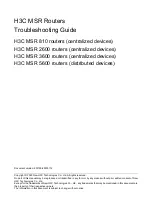
13
Troubleshooting the grounding
Typically bad grounding and common grounding
•
The device is installed in a 19-inch cabinet, but the grounding cable of the device is not
connected to the grounding strip of the cabinet.
•
The device and its peer device are in the same equipment room, both devices are grounded,
but they are not commonly grounded.
Influence of bad common grounding
Bad common grounding will cause different reference voltages on the two devices. As a result, the
Rx/Tx and other signals are not detected on the same voltage platform. Then, the data transmitted
on the local end will be different from the data received on the peer end, and error packets appear.
More seriously, the protocol might come up and go down. Additionally, the normal signals transmitted
on the local end might fail to be detected or be incorrectly detected on the peer end. As a result,
alarms will appear on physical links, and physical E1 interfaces come up and go down.
Grounding requirements
•
Make sure the devices are well grounded.
•
If the device and its peer device are in the same equipment room, both devices must be
grounded and commonly grounded.
•
The grounding cable must be a copper cable in order to reduce the high-frequency impedance.
Make sure the grounding cable is as thick and short as possible. Do not use aluminum cables.
•
Make sure both ends of the grounding cable have good electric contact and have antiseptic and
antirust processing.
•
Do not use other devices for electric contact of the grounding cable.
•
The grounding cable cannot be parallel to or twisted with signal cables.
•
The connectors, on-off switches, or fuse protectors cannot be added to the grounding cable.
•
The grounding cable must be yellow-green plastic-insulated copper conductor.
•
The grounding cable must be shorter than 30 meters, and try to be as short as possible. When
the cable exceeds 30 meters, the customer must place grounding strips nearby.
•
If an UPS is used for power supply, the UPS must also be grounded.
Reliable grounding is the basic requirements for good protection against lightening, electric shock,
and interference, and is the prerequisites for long-period reliable, stable operation of the device.
Different grounding methods in different environments
Grounding strips are provided in the installation environment
When the grounding strips are provided in the installation environment, perform the following tasks:
1.
Make sure the grounding strip is well grounded.
2.
Connect one end of the yellow-green grounding cable to the grounding post on the grounding
strip, and fasten the nut.
The sectional area of the grounding cable must be no smaller than 4mm
2
. Make sure the cable
is as short as possible, and do not twist the cable.














































